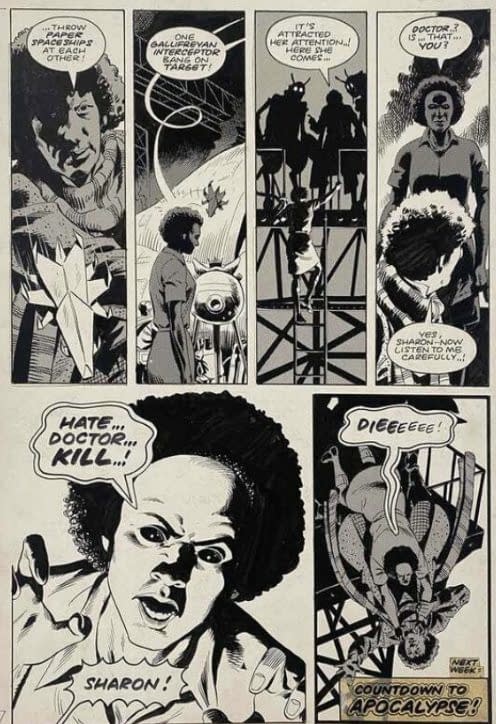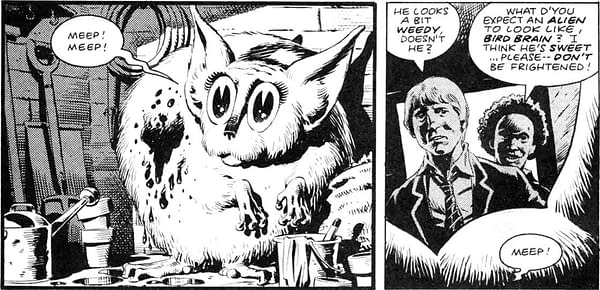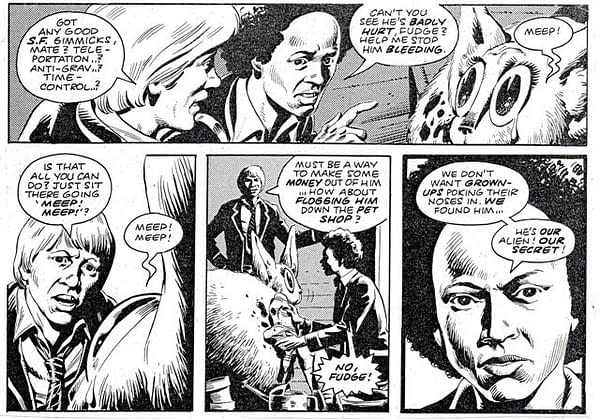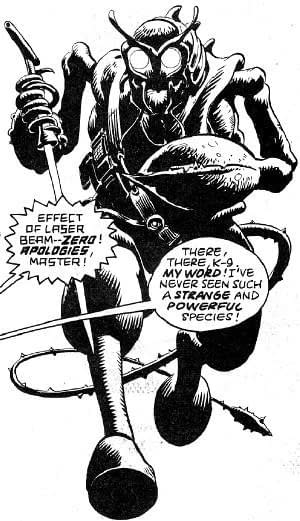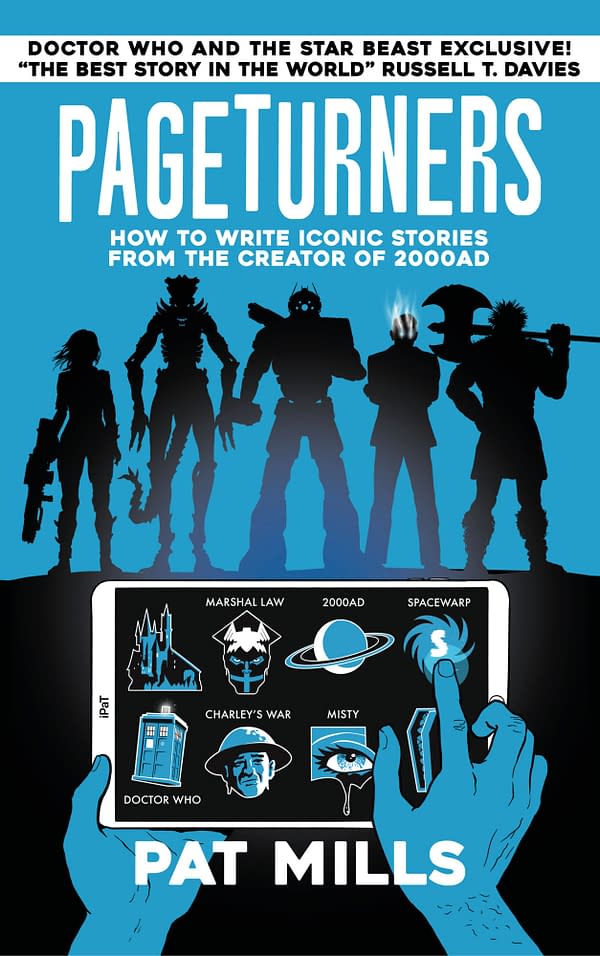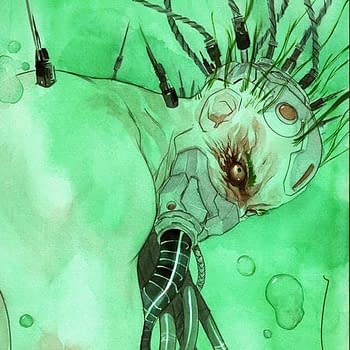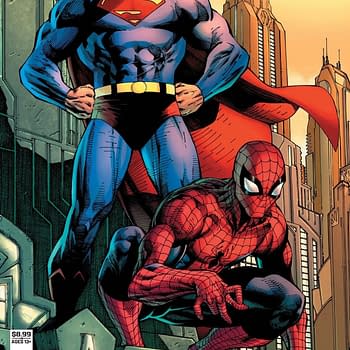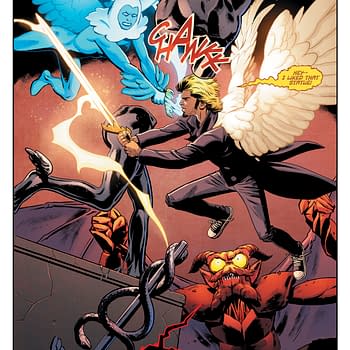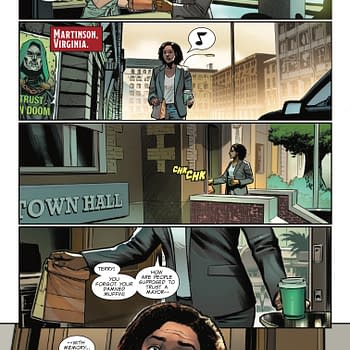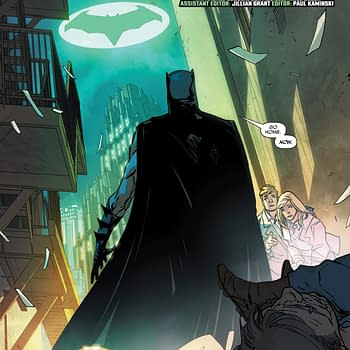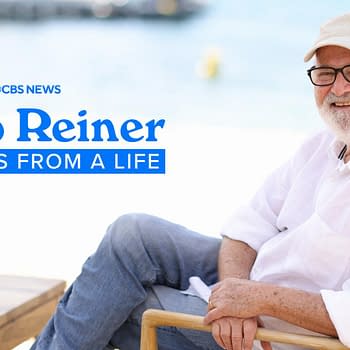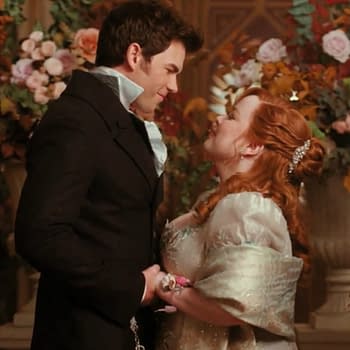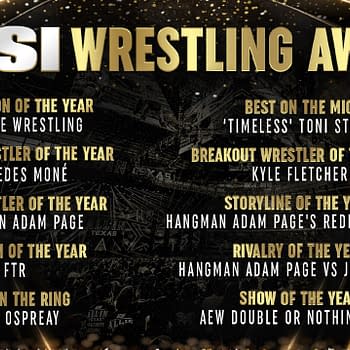Posted in: BBC, Comics, Comics Publishers, Doctor Who, Marvel Comics, TV | Tagged: Dave Gibbons, doctor who, Pat Mills, Star Beast
The Marvel Comic That Was Adapted For Tonight's Doctor Who: Star Beast
In 1980, Doctor Who Weekly, published by Marvel UK, included a new comic book strip by Pat Mills, John Wagner, and Dave Gibbons, Star Beast.
Article Summary
- 1980's Doctor Who Marvel strip 'Star Beast' adapted into a 60th anniversary episode.
- Original comic creators Pat Mills and Dave Gibbons shared their delight on the adaptation.
- 'Star Beast' included the first black companion, pioneering diversity in Doctor Who.
- David Tennant recalls the comic's impact and quality as superior to the TV show at the time.
In 1980, Doctor Who Weekly, published by Marvel Comics UK, included a new comic book strip by Pat Mills, John Wagner, and Dave Gibbons, edited by Dez Skinn, Star Beast. Pat Mills is best known as the founder of 2000AD and co-creator of Judge Dredd, Punisher 2099 and Marshall Law; John Wagner is his Dredd co-creator and the longest-serving creator on that character. Dave Gibbons is best known as the co-creator of Watchmen, Give Me Liberty, and Kingsman and the creator of The Originals. And Dez Skinn, former Marvel editor, publisher of Warrior, Captain Britain, Marvelman, V for Vendetta, Starburst, Comics International and much more. David Tennant is quoted as saying that the Doctor Who Weekly strips were "better than the telly at that time" and he read Star Beast as a kid.
And tonight that 43-year-old comic book story has been adapted into the 60th anniversary returning Doctor Who starring David Tennant and Catherine Tate, written by Russell T Davies, with Miriam Margoyles as Beep The Meep. Pat Mills will be telling us a lot more about what went down then, in his new book Pageturners: How To Create Iconic Stories From The Creator of 2000AD as an e-book tomorrow, on the 26th of November, after Doctor Who and the Star Beast has broadcast, with the paperback on sale at the same time. All paying subscribers to his Substack will also get a download link to the book tomorrow founding members will receive a signed paperback copy.
In Doctor Who Magazine, Russell T Davies wrotes "We can talk later in the year about the whys and wherefores of using that story, and how much we've changed in its adaptation from a classic old Marvel comic strip by Pat Mills and Dave Gibbons." The alien Beep The Meep appeared as the leader of the Meep armada aiming to conquer the galaxy, but was defeated by the Wrarth Warriors. Crashing to Earth, Beep The Meep was found by two humans who assumed he was harmless, one of whom, Sharon Davies, became the Doctor's ongoing companion in the comic strip, the first black companion in the history of Doctor Who in any medium.
The Fourth Doctor, flying solo for the beginning of this strip, stopped Beep from taking control of the town's humans to repair his ship, so Beep was captured by the Wrath Warriors. Subsequently, Beep The Meep made rare and occasional appearances in Doctor Who comic book strips and audio dramas.

In tonight's Star Beast, we see that Beep The Meep will make their first screen appearance in the upcoming, after crash landing on an estate. We also see new companion Rose, played by Yasmin Finney, the first trans companion for the Doctor. And the Wrath Warriors from Doctor Who Weekly in 1980. Copies of Doctor Who Weekly #19 have, as a result have sold for up to £60 on eBay. Though the colour Marvel reprint in Doctor Who #1 from Marvel USA in 1984, is a little more affordable.
Talking to Doctor Who Magazine, Pat Mills and Dave Gibbons talked about their surprise on being approached.
Pat: "Completely surprised. A BBC producer got in touch. It came out of the blue."
Dave: "It was a very uncomplicated, very positive enquiry, which isn't the sort of thing you're used to in comics, you tend to be ridden over a bit roughshod, so to have somebody be respectful and polite enough to say what they wanted to do, and ask us how we felt about it, and to talk about renumeration for it –"
Pat: "Which helps."
Dave: "– you think, yeah, maybe these guys' hearts are in the right place. The word is respect. They've been so respectful of what we tried to do."
Pat: "It was so different to most of my experiences [with screen adaptations of his work]. It's all we want, is just a little bit of respect. And we got more than that. You saw on our day on set, it was wonderful."
As to how the comic strip fitted in with the TV show at the time,
Dave: "We had this idea of some vast, intergalactic event and it boiling down to a shed in the backyard of a two-up two-down British house. I think to come back to a very recognisable England, and a pretty down-at-heel workingclass England, was a location that hadn't really been featured before. And to put in the middle of that some really fearsome intergalactic terrors…"
Pat: "The tone of the TV show at the time was… not just set on other worlds, but some of them were… how can I put it? Um, not easy to absorb. And they were slightly losing that younger audience. The stories were becoming more complex. But we were like, 'Well, we can do what we want here, because it's a comic book and no-one really cares.'"
And as for meeting Beep The Meep on the set of the show.
Dave: "Surreal. It's a dream come true."
Pat: "It was actually quite emotional. I didn't hide my feelings very well."
Dave: "It's incredible when you see something that you've laboured over in print appear in three-dimensional reality. The Meep had such a presence on set – such believability. Like something that's got a life of its own."
Pat: "Yeah, no messing around, that's the Meep."
As for the origins of the character.
Dave: "We described it as – and we both knew it was supposed to be – a cuddly furball, but I'm wondering if we based it on something…?"
Pat: "Well, it was partly based on guinea pigs, because I had this guinea pig as a kid and the noise it made was this 'meep, meep, meep' – which is the sound of the Meep. As I got home from school, this guinea pig would hear my footsteps and start going 'meep, meep'. Of course, guinea pigs have a certain viciousness about them too. Then I remember – get the violins out – my guinea pig died –"
Dave: "Oh Pat, don't put yourself through it, mate."
Pat: "– so my mum got me another one, and the neighbour's kid picked it up and dropped it, so that one died as well. After that, we decided no more guinea pigs."
They have a similar reaction to Beep The Meep's space ship.
Pat: "I'm only used to seeing it from that opening page of the comic"
Dave: "Yes, kind of side on."
Pat: "– but we saw it from every different angle."
Dave: "And that steelworks set was vast. And real! I was in awe. Also, it was a good cardio workout, climbing all those stairs."
Pat: "It seemed to me like the set of a major movie. The scale of this production… I was quite gobsmacked. This is a quantum leap forward."
Dave: "But like the comic, I think it's being made by fans for fans."
As for the representative issues;
Pat: "There was a sense we were doing something mildly groundbreaking, and no-one was telling us not to. Also being able to say things like, 'Let's have a black companion for the Doctor.' It was really important at the time, because black characters rarely featured in British comics."
Dave: "I'm very proud of the fact that we gave the Doctor a young, black female companion."Pat: "Whereas now it's making a point of celebrating diversity. And we have to keep on doing it, because there's still a bit of an imbalance in some areas. Yeah, the more diverse the characters the better. In the case of Sharon, I also wanted to capture that British, Grange Hill feel. I was a huge fan of Grange Hill."
Talking on his Substack about Star Beast (seriously, subscribe today and get the full book tomorrow, as well as access to everything else for a month), Pat Mills recalled
"Star Beast was especially memorable because it featured a feisty, black, female companion, Sharon, and had a strong, working class Grange Hill feeling to it; in fact, later, I wrote the comic book version of Grange Hill for Beeb comic. I'd pioneered black protagonists elsewhere. And, at the time, it really was a big deal. For 2000AD, I'd created Harlem Heroes, a group of black future sport heroes which Dave Gibbons drew to perfection. And Blackjack in my Action comic – the story of a black boxer which John Wagner wrote. My managing editor had tried to dissuade me. He insisted it would be better to have a white boxer with a black sidekick! Really! So it was important to challenge this kind of racism wherever it appears. Including the conspicuous absence in comics of characters from different ethnicities. And, I'm sorry to say, that managing editor's attitude can't easily be dismissed as the prejudice of a past generation. I had a black heroine, Eve, in my Third World War and I wrote many of the black issue episodes with a black writer, Alan Mitchell. I was told specifically by editorial that there was definite reader resistance to so many black characters. I also had incredible difficulty finding artists who could portray a black heroine in a positive way. Truly! It looks effortless when Dave draws Sharon to perfection, but believe me, many British artists struggled with black heroines. Alan Mitchell and I would shake our heads in despair at some artists' preliminary drawings of Eve. So Dave's depiction needs especially commending. He makes it look so easy. And of course, he went on to draw his excellent black heroine Martha Washington. We have to push back against such ingrained attitudes, doubtless the legacy of Britain's colonialism. I'm reminded of Alan Barnes when he was editor of the Megazine and he commissioned me to write Black Siddha, the story of an Indian superhero living in London. He anticipated some resistance from some readers but that only seemed to encourage him. Bravo, Alan! He felt, as I do, that the days of comics with all-white male protagonists aimed at a supposedly all-white audience were surely over, whether some readers liked it or not. So for all these reasons, the appearance of Sharon in Star Beast was very important to Doctor Who comic. Particularly as we were way ahead of the TV series at that time."
David Tennant has fond memories of the Doctor Who Weekly and its comic book strip, which still runs to this day in Doctor Who Magazine, published by Panini who bought out Marvel UK in the Marvel bankruptcy in the nineties. Tennat was there with issue 1 in 1979. He tells DWM;
"There had been Doctor Who comics before, I remember them from TV Comic back in the day, but they'd always been a bit scrappy and slightly shoddy – no offence to those who I'm sure worked very hard on them. But suddenly with Doctor Who Weekly… well, it was a Marvel comic strip, it was that quality, like a different level. It looked great. It was the first time that a Doctor Who comic strip felt, to someone who loved the show, like it got the measure of the source material. It represented the TV show that it came from. The Doctor was recognisable. It took the source material seriously, as eight-year-old me believed it had to be taken… They were stories that you could imagine being on the TV, if the TV show had a multi-million pound budget. Pat's an amazing writer. And Dave's a great artist, isn't he? What was nice was him being enthusiastic to see his designs being shamelessly ripped off – 40 years on! The Meep is a beautiful design. As are the Wrarth Warriors. So of course, we didn't change them barely at all. I believe there was a bit of a journey in designing, particularly the Wrarth Warriors, where the Art Department went kind of far from the source material but then ended up coming back to it, because they couldn't better it. Dave drew everything so beautifully. And Pat and John's stories carried you along."
Doctor Who: The Star Beast is on BBC1 from 6.30pm tonight, and available worldwide (aside from Britain and Ireland) on Disney+. Panini recently collected Star Beast by Pat Mills, John Wagner and Dave Gibbons in Doctor Who: The Fourth Doctor Anthology. And Pageturners: How To Create Iconic Stories From The Creator of 2000AD by Pat Mills is published tomorrow, and free to his paying Substack subscribers.


